Two men are in the car. The larger one drives, the smaller one — well, he can’t drive right now. But that’s okay. What’s important is that wherever they’re heading, they’re heading there together. They’re friends. And in the weird and wild world of the ‘60s, where the music swings and the colors pop and the freaks are coming, you need someone to have your back.
If there’s one thing the Batman and Robin of Batman 66 are not, it’s freaks. “Under this garb we’re perfectly ordinary Americans!” Robin ejaculates at a press conference following the dynamic duo’s latest exploits, which involve being tricked by a hologram of a boat and attacked by an exploding shark. He’s not wrong — it’s not just that Batman and Robin are secretly millionaire playboy Bruce Wayne and his ward Dick Grayson. They represent a singular squareness, a rectangular rectitude. It’s self-evident and unimpeachable, and thus delivered in a deadpan that makes its obviousness hilarious. “Salt and corrosion,” Batman muses upon encountering a rusty buoy, “the infamous old enemies of the crimefighter.” But while crimefighting can be adversarial, it also reflexively includes decency: the gin-soaked degenerates of a waterfront bar “may be drinkers, Robin, but they’re also human beings.”
Batman’s enemies are human in the sense that they have no superpowers, but they have little humanity and no ordinariness. The Batman TV show this movie is based on — you can’t really call this a comic book movie, the aesthetic is entirely televisual — was known for its campy and over-the-top style, including lots of Dutch angles. Those are present here, but director Leslie H. Martinson uses them exclusively when framing the film’s four villains as they plan their schemes. Their plot to lure Batman to their lair in order to use a giant jack-in-the-box to fling him out a window into the arms of an exploding octopus might seem deranged enough, but the camera emphasizes the off-kilter world these rogues live in. Their ultimate plan is to use a revamped instant whiskey machine to dehydrate members of the United World Council and ransom the resulting international dust piles for $1 billion from each country involved (to be delivered by hordes of carrier pigeons to the gang’s secret island). In 1966 it may have felt like the freaks were taking over the world — these weirdos aren’t just conquering the planet, they’re imposing their own insanity on it.
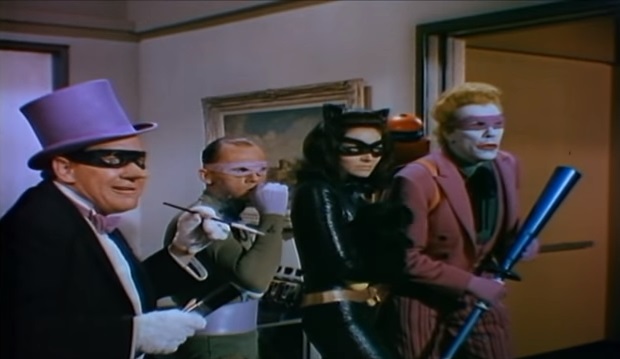
Lee Meriwether’s Catwoman, the de facto leader based on brains and a relative lack of lunacy, combines sultriness and cat puns while Burgess Meredith’s Penguin is more birdbrained and prone to sneering and mugging with a patrician superiority. The Joker has eclipsed the Dark Knight’s other villains in recent years, becoming freighted with the significance of a doppelganger at the least and the power of chaos itself at the most — Cesar Romero has none of that, generally acting goofy and having a ball and embodying Nick Pinkerton’s immortal description of the character as an actor’s apex, “the clown who fights Batman.” The Riddler, of all people, is by far the most menacing of the quartet, which is down to Frank Gorshin’s intense capering and murderous stares — the Joker is having too much fun to kill, but the only thing keeping the Riddler’s victims alive is his need for an audience.
His riddles are the purest manifestation of the absurdity these maniacs embrace. Writer Lorenzo Semple Jr., who wrote the bulk of the TV show’s first season (also 1966), taps into a backwards reasoning that has the inductive logic of a wacky eight-year-old when the puzzles are looked at as a whole but makes no deductive sense whatsoever. And yet deduction is how Batman and Robin arrive at their solutions, time and again — not only determining that an attack at sea means C for Catwoman, but that the aforementioned explosive shark chewing on Batman’s foot equates to the ferocious fish “pulling his leg,” ergo the work of the Joker. While Adam West is the master of the deadpan read, solving these riddles generally falls to Burt Ward as Robin and Ward’s steely certainty as he intones the solution to “What weighs six ounces, sits in a tree, and is very dangerous?” — “A sparrow with a machine gun!” — is heroic, normalcy grimly staring into the abyss yet refusing to fall in. It helps that Batman always has his back, no matter how ludicrous the solution: “That’s right, Robin!”
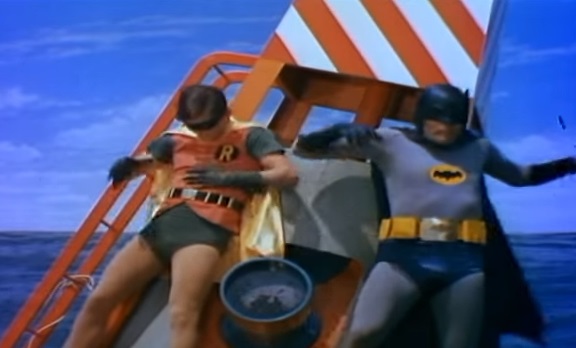
Robin has Batman, Batman has Robin — the latter follows the bro code while he and Alfred monitor a date between Bruce Wayne and Catwoman (disguised as Kitka, a Soviet journalist) who delightfully describes Batman as a “masked cossack.” Things get hot and heavy (Pimp Daddy Bruce Wayne: “I’ve never met a girl with such a potent argument for international relations”) and Alfred, the perv, wants to keep spying via tiny camera. Robin shuts him down. Some things aren’t meant to be watched. The irony, of course, is that Robin’s kindness is in the service of just another betrayal, someone else letting Batman down. Although he would never openly criticize our government, the Caped Crusader is visibly and rightfully disgusted when he finds out the Pentagon blithely sold a decommissioned submarine to one P.N. Guin, who doesn’t have any address other than a P.O. box. It’s just more absurdity and frustration he has to deal with, which culminates in the famous sequence (referenced by Christopher Nolan of all people) where Batman tries to ditch a large explosive by the waterfront. In short order, he is stymied by a group of nuns, a crying baby, a marching band, a group of divers, a pair of lovers, the nuns again, the band again, and some adorable ducks. “Some days, you just can’t get rid of a bomb,” West ruefully muses, and Camus looks upon “The Myth of Sisyphus” and is appalled at his lack of imagination.
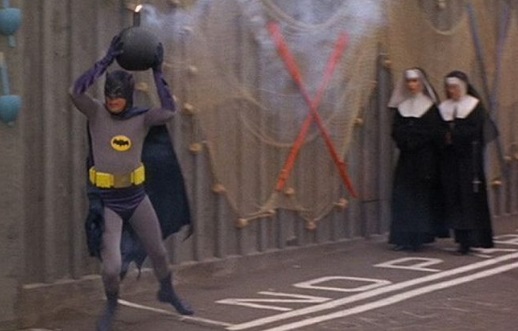
It’s enough to drive anyone to violence. Almost no one dies in the movie — oh, a few henchmen are dehydrated and then rehydrated with heavy water, making them unstable at an atomic level and thus quickly turned into antimatter by the briefest physical contact, but that’s not the same at all — but quite a few people (and one exploding shark) get thoroughly owned. The final free-for-all is a bit of a disappointment in this regard. It’s full of all the WHAPs and THWACKs and ZWAPPs and URKKs and PLOPs that the TV show loved to throw out, but it’s in service of a pretty goofy fight scene where everyone winds up getting tossed in the ocean. More interesting is Batman, a guy famous for not killing, getting righteously pissed when he thinks an innocent person (specifically his Russian squeeze) is in jeopardy. When told the Riddler is threatening her, he promises to “bash him brutally,” and when the rest of the male villains taunt him with the possibility of her being hurt, he pulls no punches, literally or figuratively. “I’ll kill you all! I’ll rend you limb from limb!” West shouts, serious as a heart attack, before he pounds the shit out of everyone, sending one henchman (in glorious fake dummy form) to that explosive octopus death intended for him instead. It’s one thing to exist in a crazy world, but when that world beats down your door and threatens those you care about? Give no quarter, spare no one, leave only broken bodies on the floor.
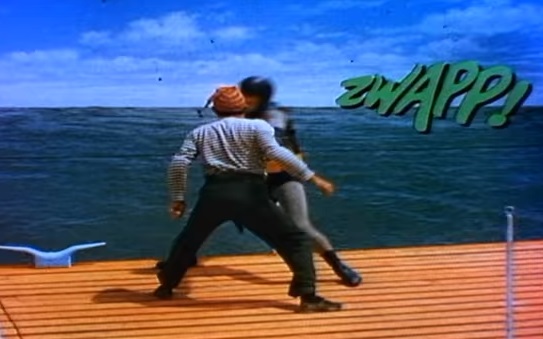
The overall vibe of the movie, though, is cheerfully dutiful. The villains’ plans may be more grandiose than usual, but villains gonna villain and Batman and Robin are going to have to stop them. There’s a job to do and doing a tough job with the possibility of real failure is better than no one needing you to do the job at all. The film creates an absurd world and makes Batman and Robin more absurd by refusing to succumb to it.Even their trust in each other becomes ridiculous:
Robin: Are you sure you didn’t hurt your head in that fight, Batman?
Batman: Perfectly. Here, swallow this pill.
Robin: Thanks.
It’s laugh-out-loud funny, but the pill does protect Robin from an ambush that Batman has seen coming. And it’s worth recalling the cards that open the movie dedicating the film to “the enemies of crime” but also the “lovers of the ridiculous and bizarre.” If Batman and Robin — gaudily costumed and perfectly normal Americans — do not love the ridiculous and bizarre, the movie does not hold that against them. They are ridiculous and bizarre in their own way, which never makes them any less than dedicated enemies of crime and defenders of the normal. “It’s just one of those things in the life of every crimefighter,” a sad Batman tells Robin as he realizes his potential soulmate was a crook all along. This isn’t the kind of movie that will let the hero find happiness in that kind of love. But it will help him in other ways.
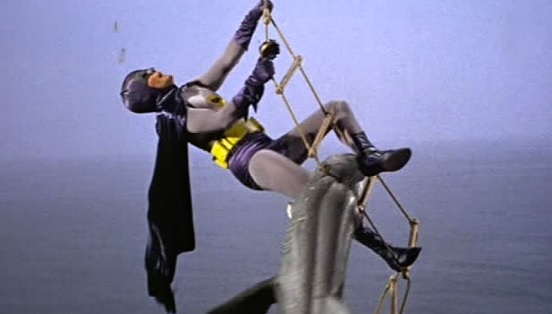
At multiple points in the film, Batman and Robin face certain death — a torpedo bearing down on their motionless bodies, a Bat-Copter falling from the sky with no landing gear — yet are saved by off-camera events. “The nobility of the almost-human porpoise,” leads a self-sacrificing cetacean to jump in front of the torpedo, while the Bat-Copter makes a soft landing on the wares of a presumably annual Foam Rubber Salesman Convention. These reversals are overtly ridiculous, eye-rollingly bizarre. Batman and Robin are men of great strength and resolve (the former does get rid of that bomb in the end), but in these places the narrative contorts itself to save them — it won’t let them escape their absurdity but it won’t let them die. That’s what makes this a fairy tale in the end, something that may have been made in a certain time but is itself timeless.
Twenty years after this movie came out, comic book fans would vote to beat a new, different Robin to death. By then, Batman had already gotten old and beat up Superman. This film isn’t even called Batman anymore, because that title was usurped by another movie, a kinkier and darker flick where lots of decent people die, and that was the movie that became Batman because it set the tone for the character for the next 30 years. Batman is now a guy who is fighting the freaks and in danger of losing himself. A hero trapped in something much worse than an absurd world, a cinematic universe — a place where everything must line up according to the logic of bean counters and market research and corporate availability. A man who almost never has a partner to help him out.
Batman is a strong enough character to encompass all of those things, but Batman 66 is an out from that future. As a fairy tale it’s a triumph and a trap, a hermetically sealed world of madness that is also a reinforcement of the status quo. A closed loop. Or maybe a racetrack, where the drive is challenging and frustrating and fun and always leads you back to the same place again. A drive that’s not so bad with a buddy riding shotgun.

